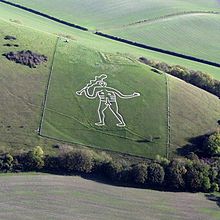Cerne Abbas Giant
The Cerne Abbas Giant (German Cerne-Abbas-Riese ) is a scratching image on a hillside near Cerne Abbas north of Dorchester in the southwestern English county of Dorset .
shape
The figure is on a large fenced area of grass. Its 60 cm wide outlines are drawn as trenches in the turf and strewn with lime gravel.
The giant himself is 55 meters tall and holds a long club above his head in his right hand, which increases the height of the entire picture by another 11 meters. The right arm is bent, the left one stretched out a little further. Under the figure's left forearm, from the elbow to the wrist, an area was once drawn that is no longer visible today. The legs are open for walking , the feet both point to the right.
Within the outline, the more than 7-meter-long phallus , which is known in art history as an ithyphallic limb due to its immense size , is particularly striking. It also shows nipples , pectoral muscles and three ribs . The head is proportionally very small, eyebrows , eye holes and a narrow mouth can be seen on the face .
origin
The age of the giant is unknown. It is mentioned for the first time in 1694, when a church chaplain recorded the repair "of ye Giant" . John Hutchins ' History of Dorset from 1774 states that the giant was not dug until Lord Holles' time, i.e. between 1641 and 1666.
The Celts were also suspected to be the originator. After all, thermoluminescence dating in the case of White Horse Hill suggested a prehistoric origin. The Irish god Dagda and the Gallic thunder god Taranis had a club. Also Thor is seen in the giant. Another theory assumes that the giant was Hercules , created in Roman times around 200. The area under his left arm would then be identified as the skin of the Kitharonic lion .
Against these assumptions, however, the fact that the giant is not mentioned in writings before 1694, in contrast to other presumably prehistoric scratching images such as the Uffington White Horse . The monumental chalk inlay with the ithyphallic limb could be a tribute to the English King Wilhelm III. to be from Orange , who is celebrated as a natural demigod; or a caricature of Oliver Cromwell , who grossly overestimates himself as a naked Hercules.
In July 2020, preliminary reports were published on an evaluation of soil samples taken from the giant's feet and elbows. Remains of the snail species Cernuella virgata , which was only introduced to England in the 13th or 14th century, were found in the samples . Accordingly, the scratching must be a work of the late Middle Ages or the early modern period . Further studies using optically stimulated luminescence are planned for autumn 2020. They should narrow down the time of origin even more precisely.
maintenance
To prevent the lines from becoming overgrown, a restoration is required about every 10 years; the last one took place in August and September 2019. A renewal cycle of 7 years has even been handed down from the 18th century.
Changes may have occurred over time, for example the phallus shows signs of enlargement. It is possible that the phallus only achieved its present size by merging with the navel (as can be seen in older drawings), which was originally shown separately.
Rituals
In modern popular belief, the giant is a fertility bringer. In 1922, JS Udal, in Dorsetshire Folk-Lore , wrote that couples should love each other on the phallus so that their desire for children would be fulfilled. In 1968, HSL Dewar noted that women ran away from giants in the hope of finding a partner, swearing allegiance or having children. Wicca -Anhänger regularly organize fertility rituals and the giant Beltane celebrations.
Picture gallery
Drawing from 1794 with dimensions (in feet )
literature
- Jacqueline Simpson, Steve Roud: Cerne Abbas Giant. In: A Dictionary of English Folklore. Oxford University Press, Oxford, 2000.
Web links
Individual evidence
- ↑ a b Entry in Historic England , accessed April 18, 2019
- ↑ Stefan Trinks: Archeology of a chalk figure: younger than thought. In: faz.net . July 9, 2020. Accessed July 10, 2020.
- ^ Richard Hartley-Parkinson: Volunteers polish giant's erection by hand. In: metro.co.uk. August 29, 2019. Accessed September 8, 2019.
- ↑ On this, Leslie Grinsell in Antiquity, No. 54. 1980. pp. 29–33
Coordinates: 50 ° 48 ′ 49.3 " N , 2 ° 28 ′ 28.8" W.






